Major
JOHN PITCAIRN,
Marines
1722/3-75

John (left) and Francis Smith
supervise the destruction of Rebel arms at Concord
Engr. by Amos Doolittle after Ralph Earl
John Pitcairn was baptised at St. Serf's, Dysart,
on 28 December, 1722 (Old Calendar - 1723, New Calendar): his date of
birth is not recorded separately, so it may have been the same day.
He was the youngest surviving child of the Rev. David Pitcairn, M. A.
(St. Andrews), former regimental chaplain to the Cameronians and
veteran of Blenheim, who served as minister of Dysart for 49 years,
and his wife Katharine Hamilton of Wishaw.
In his early 20s, John married Elizabeth Dalrymple (1724-1809).
Their first child, Annie, was born in Edinburgh in 1746, in which
year John was commissioned Lieutenant in Cornwall's 7th (Marines)
Regiment.
Soon after that, however, the Marines were disbanded. When they
were established permanently in 1755, John's Lieutenancy was
reconfirmed. The following year, he was promoted Captain. He served
during the Seven Years' War, and in 1757 (when his father died, and
his daughter Johanna was born in Dysart) was aboard the warship
H.M.S. Lancaster - presumably en route to Canada, where the
Lancaster was involved in the taking of Louisbourg. The Pitcairns
moved down from Edinburgh to Kent in the early 1760s, when John
became permanently attached to the Chatham division of Marines.
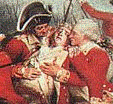 John
and Betty had six sons (one of whom, Clerke, died young) and four
daughters. Their Dysart-born eldest son, David, followed his uncle
Dr. William Pitcairn to become an eminent physician at Bart's, and,
eventually, physician to the Prince Regent. Physically, it was he who
most closely resembled his father. In 1786, when the American artist
John Trumbull came to London to make sketches for his painting
The Death of General Joseph Warren at Bunker
Hill, he based his likeness of John upon Dr. David. (The
detail shown here links to Ed the
Saint's site) Robert, born in Burntisland, became a
midshipman. In 1767 he sighted the Pacific island named in his
honour, but was lost at sea in 1770, aged only 17. William, born in
Carnbee, followed his father into the Marines, while Thomas joined
the army. The girls - Annie, Katharine, Johanna and Janet - all
married army or naval officers of good family. The youngest child,
Alexander, born in Kent in 1768, eventually became a barrister in
London.
John
and Betty had six sons (one of whom, Clerke, died young) and four
daughters. Their Dysart-born eldest son, David, followed his uncle
Dr. William Pitcairn to become an eminent physician at Bart's, and,
eventually, physician to the Prince Regent. Physically, it was he who
most closely resembled his father. In 1786, when the American artist
John Trumbull came to London to make sketches for his painting
The Death of General Joseph Warren at Bunker
Hill, he based his likeness of John upon Dr. David. (The
detail shown here links to Ed the
Saint's site) Robert, born in Burntisland, became a
midshipman. In 1767 he sighted the Pacific island named in his
honour, but was lost at sea in 1770, aged only 17. William, born in
Carnbee, followed his father into the Marines, while Thomas joined
the army. The girls - Annie, Katharine, Johanna and Janet - all
married army or naval officers of good family. The youngest child,
Alexander, born in Kent in 1768, eventually became a barrister in
London.
In the Marines, unlike the army, commissions were not purchased,
and so it was only in 1771, aged 48, that John reached the rank of
Major. In early December 1774, as unrest spread in the Colony of
Massachusetts, he arrived in Boston with some 600 Marines drawn from
all three divisions: Chatham, Portsmouth and Plymouth. He had to
contend with a dispute between Admiral Graves and General Gage over
landing them, and the fact that they had no proper winter clothing
and equipment.
The Plymouth Marines had been sent out with inadequate officers,
who could not keep order. As a result, they proved an ill-disciplined
trial. Indeed, when John got them ashore, he was astonished by the
Marines' poor appearance in comparison with the army. He wrote to the
Admiralty, suggesting an end to the recruitment of men under 5' 6".
He also observed that issuing uniforms with white facings were not a
good idea, given the men's difficulty in keeping themselves
clean.Some Marines were selling their kit to buy the lethal local
rum, which killed a number of them. John spent several weeks living
in barracks with them to keep them sober. He was a humane man, to
whom harsh punishments went against the grain. The fact that he had
to have some of the Plymouth "animals" (his word!) flogged distressed
him. Respected and popular, he eventually succeeded in drilling them
into an effective force.
John was billeted on Francis Shaw, a fiercely anti-British
tailor, neighbour to Paul Revere on North Square, and ancestor of the
Civil War hero Robert
Gould Shaw. Remarkably, despite their political differences, he
won over his reluctant host on a personal level. According to Shaw
family tradition, John prevented a duel between young Lieutenant
Wragg, also billeted on the household, and Sam, Shaw's equally
hot-tempered teenaged son. The Lieutenant had made some anti-Rebel
remarks, and Sam had responded by throwing wine on him. Fortunately,
John was able to defuse the situation with his characteristic warmth
and good humour. Sam must have learned his lesson, since he later
became a diplomat!
Other Boston radicals also came to respect John's integrity,
honesty, and sense of honour, and trusted him to deal justly in
disputes between the locals and the military. His genial charm gained
their affection: even the Rebel preacher and propagandist Ezra Stiles
describing him as "a good man in a bad cause". Every Sabbath he
attended Christ Church, but during the rest of the week he was noted
for his profane language. He held salon at Shaw's house, where
British officers and locals, including Revere, could meet, socialise,
and exchange views in a civilised manner. He also had family company:
his sons William and Thomas - the former a Lieutenant in the Marines,
the latter in the Royal Artillery - and his daughter Katharine's
husband, Captain Charles
Cochrane, a younger son of Lord Dundonald.
On 19 April 1775, John Pitcairn was second-in-command of the
troops sent to destroy Rebel stores in Concord. At Lexington Green,
they came face-to-face with a body of armed American militia. John
ordered his men NOT to fire, and commanded the militiamen to
lay down their arms and disperse. They began to do so, but, as John
wrote in his report to Gen. Gage:
- ...some of the Rebels who had jumped over the Wall, Fired Four
or Five Shott at the Soldiers, which wounded a man of the Tenth,
and my Horse was Wounded in two places, from some quarter or
other, and at the same time several Shott were fired from a
Meeting House on our Left - upon this, without any order or
regularity, the light Infantry began a scattered Fire, and
Continued... contrary to the repeated orders both of me and the
officers that were present...
There is still controversy over the source of the first shot;
possibly provocateurs from extremist circles in Boston were involved.
Despite John's efforts to restore order, eight 'Minute Men' were
killed. The American War of Independence began as news of the
shootings spread to the neighbouring villages. After continuing and
fulfilling their mission to destroy the arms stores in Concord, the
British came under heavy fire on the road back to Boston. They
suffered severe casualties. At Fiske's Hill John's horse was again
grazed by bullets, and threw him. He was forced to march the rest of
the way, as the wounded animal had bolted into the American
lines.
It is alleged that the horse took with it his brace of richly
decorated metal scroll-butt pistols, made by John Murdoch of Doune.
The pistols were presented as a trophy to the Rebel officer Israel
Putnam. They are displayed in the Hancock-Clarke Museum in
Lexington during the tourist season, and off-season in The Museum
of Our National Heritage, also in Lexington. However, there is a
question-mark over their provenance: the heraldic crest engraved on
the escutcheon plates depicts three swords, with a snake twined
around the middle one. This does not resemble the known crest
of the Pitcairns of Forthar, a moon rising from a cloud. So whose the
pistols really were is uncertain.
On 17 June, the British launched 3 assaults on the American
position at Bunker Hill (actually on Breed's Hill) at Charlestown,
near Boston, and won the day - but at horrific cost: 50% killed and
wounded. Even the surgeons were horrified at the number of double
leg-amputations needed because the Rebels, low on bullets, had
stuffed their guns with broken glass, nails, and scrap metal.
Among the casualties was John Pitcairn. In the summer heat he led
his Marines - including his own sons - on foot up the hill, to take
part in the third attack. While advancing, they crossed another line
of infantry, who were being pushed back by heavy Rebel fire. John
told them to "Break, and let the Marines through!", and, more
colloquially, is said to have threatened to "bayonet the buggers" if
they would not! Waving his sword, he urged his men on: "Now, for the
glory of the Marines!" - Then a musket-ball smashed into his breast,
and he collapsed into William's arms. While the Marines charged
forward in the final assault, the young Lieutenant carried his
wounded father out of the line of fire, before returning to the
battle. The boy was so bloodied that some witnesses thought that he
himself was hurt.
John was taken by boat back to Boston, and put to bed in a house
on Prince Street. He was conscious, but, experienced veteran that he
was, he knew his chances were poor. The army surgeons were overworked
because of the heavy casualties, so General Gage, anxious to save a
valued officer, sent a Loyalist town physician, Thomas Kast, to tend
him. John told Dr. Kast - at 25, of an age with his own doctor son -
that he was bleeding internally and would die soon. Kast asked him
where he was hurt. He placed his hand upon his chest: "Here". The
young doctor suggested that it might not be fatal, and made to turn
down the sheet, but John refused to move his hand. Kast tried again;
still the Major kept his hand pressed over the sheet across his
wound. Firmly but courteously, he asked him not to touch him until he
had set his affairs in order. Only then did he submit to an
examination. But when Kast pulled John's waistcoat away from his
breast, the blood gushed out, staining the floor. The wound was
dressed, but within a couple of hours, while Kast reported back to
the General, John died from the effects of the hæmorrhage. He
was 52.
When William told the Marines: "I have lost my father!", some of
them responded: "We have all lost a father!" Mourned by friend and
foe alike, Major John Pitcairn was buried in the crypt of Christ
Church, 'the Old North Church', in Boston. The fatal bullet and his
uniform buttons were returned to Betty and the children - the
youngest of whom, Janet and Alexander, were aged only 14 and 7
respectively.
There is no authentic portrait of John Pitcairn, other than a
cartoonish image by Earl and Doolittle. The frequently reproduced
miniature, charming though it is, is too late, judging by the style
of the uniform. It may represent his son Thomas; or else be derived
from the 1786 Trumbull painting, for which Dr. David posed.
Old North Church, Boston, Mass.
It has been alleged that in 1791 the family sent for John's body
to be reinterred in his brother Dr. William Pitcairn's vault at St.
Bartholomew the Less in London. The story goes that a Boston doctor,
Amos Windship, a notorious conman and crook, exploited the Pitcairns
for personal gain, and sent them another body instead. However, the
Old North Church in Boston is sure it has got the real John
Pitcairn, and there is no entry in the burial register at
Bart's about the alleged re-interment. The only Pitcairns buried
there are John's brother Dr. William (d. 1791), son Dr. David
(1749-1809), Betty Dalrymple, John's widow, who outlived her son by
only a month (1724-1809), and David's widow, Elizabeth Almack
(1759-1844). So this looks very much like an old wives' tale.
There is a modern-looking plaque in Old North Church, Boston. It
mistakenly refers to his corps as 'Royal Marines' - the 'Royal'
designation was granted in the early 19C:
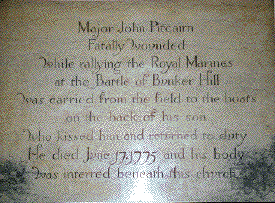
Major John Pitcairn
Fatally wounded
while rallying the Royal Marines
at the Battle of Bunker Hill
was carried from the field to the boats
on the back of his son
who kissed him and returned to duty
He died June 17, 1775 and his body
was interred beneath this church
Photo: Frank
Collins
Dysart, Fife.
John's birthplace, the old manse of Dysart, was demolished over a
century ago. The marble plaque John erected to his parents' memory in
1757-8 in St. Serf's was destroyed by vandals in the early nineteenth
century, after the kirk fell into ruin. As a result, until recently
there was nothing to commemorate John in his hometown.
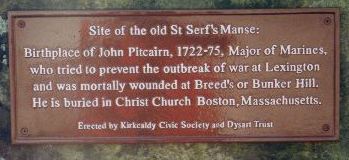
Photo: M M
Gilchrist
For the past couple of years I have been working with the
Kirkcaldy Civic Society and the Dysart Trust to get a plaque
installed in John's memory near the site of the old manse. On
Saturday 13 April 2002, it was unveiled in a small ceremony involving
Ann Watters and Jim Swan of the KCS and Dysart Trust respectively,
genealogist Mrs. Sheila Pitcairn, and yours truly. John is now the
first of 'our boys' to get a memorial plaque here in Scotland!
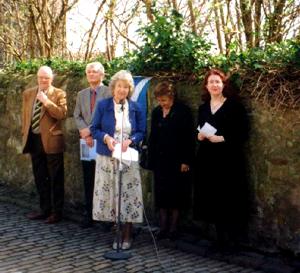
Anne Watters, Kirkcaldy Civic Society,
speaks.
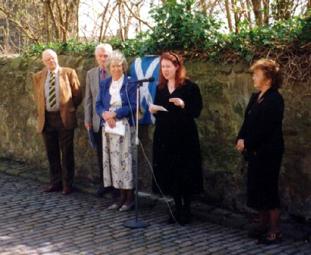
Yours truly.

Sheila Pitcairn performs the unveiling
honours.
Return to Top





